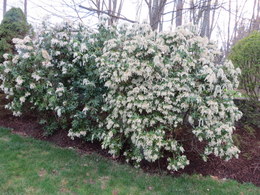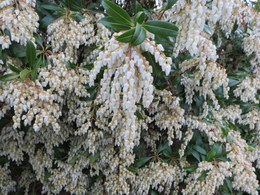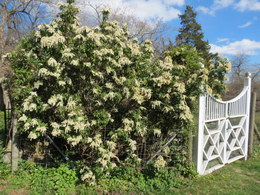Andromeda Growing Guide
Andromeda (Pieris japonica) also called Japanese andromeda, Japanese Pieris and lily of the valley shrub. It is an herbaceous perennial shrub that is native to Japan, Taiwan and China and will do well in USDA Zones 5 to 8.
The blooms take the form of long dangling clusters of small bell-shaped flowers ranging from creamy white or light pink and maroon and appear from early to late spring and last for many weeks.
Andromeda is an ornamental broadleaf evergreen with new reddish growth in the spring turning into dark green leaves that will give beautiful color year-round. This extremely attractive broadleaf evergreen features an amazing color show year-round and will make a beautiful privacy screen or a foundation plant.
There are many common varieties of andromeda that reach a mature height of 6 to 8-feet high with a spread of 5 to 8-feet. Compact varieties reach a mature height of 3 to 4-feet and a spread of 3 to 4-feet and some dwarf varieties that have a mature height of 1 to 2-feet high.
In addition to being deer resistant it is a nectar plant for butterflies and pollinators.
Soil Preparation
Plant your andromeda in full sun to part sun in the warmer southern growing zones and in full sun in the cooler growing zones in a nice loose well-drained garden soil.
As soon as the soil is frost-free and can be worked, till the soil by digging down 8 to 12-inches turning the soil over with a garden fork. Remove any large rocks, the small pebbles remaining will do no harm and actually benefit the soil by adding some micronutrients to the soil. It will do best in a slightly acid soil with a pH range of 6.0 to 7.0.
Planting Andromeda
Follow the grower’s instructions. In general, plant in the late spring after the last expected frost or early fall.
Dig a hole as deep as the pot and twice as wide. To the soil you just removed add the same amount of good garden soil so you have a nice blend of new and native soil.
Take out of the pot and gently loosen the root ball pulling away any roots that have grown in a circle around the pot.
Place the root ball in the hole with the growing crown of the plant even with or an inch or two higher than the surrounding soil. Gently spread out the roots and back fill the hole around the root ball leaving a shallow depression around your plant. Fill the depression with water to settle the soil around the roots adding more soil if necessary and water again. Water daily tapering off as the roots grow and get established.
If you are planting as a group of 2 or 3-shrubs, space them 6 or 7-feet apart to give them good air circulation between them.
Watering and Care
Andromeda is low maintenance and easy to care for. All you need to do is add a layer of mulch to help retain moisture and keep out competing weeds. They should get an inch of water each week and during dry spells give some water to keep the soil moist.
They usually do not need any fertilizer, but a light side dressing of organic fertilizer such as Espoma Azalea-tone can be placed around the plant in the spring when the soil warms up and new growth emerges.
Pruning is usually not needed, but if a light trim is needed do it after the blooms have faded.
Diseases and Pests
Andromeda does not have any serious diseases or pests.
Tips and Warnings
Andromeda as well as daffodils and rhododendron plants should be considered toxic to humans and animals. If you think that someone or an animal is sick due to poisoning get medical attention quickly.
Popular Varieties
Some popular Pieris japonica varieties: Brouwers Beauty, Cavatine, Dorothy Wycoff, Katsura, Mountain Fire, Mountain Snow, Scarlet O'Hara.
Sources: Nature Hills Nursery, Fast Growing Trees, White Flower Farm.
Garden Spikes newsletters give you timely information once or twice a month. Subscribe Free to the Garden Times newsletter below.
Your email address will only be used to send you a newsletter and will never be sold. You can unsubscribe at any time.



